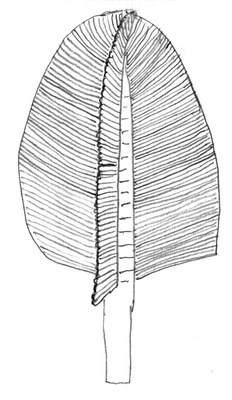Swartpuntia
| Swartpuntia | ||||||||
|---|---|---|---|---|---|---|---|---|

Reconstruction of Swartpuntia. For the sake of clarity, only three fronds are shown. |
||||||||
| Temporal occurrence | ||||||||
| Ediacarium | ||||||||
| 546 to 542 million years | ||||||||
| Locations | ||||||||
| Systematics | ||||||||
|
||||||||
| Scientific name | ||||||||
| Swartpuntia | ||||||||
| Narbonne , Saylor & Grotzinger , 1997 | ||||||||
| species | ||||||||
|
||||||||
Swartpuntia is a fern-frond-like, frondomorphic fossil from the late Ediacarian , which is countedamong the Erniettomorpha andbelongs to the Nama community of the Ediacara biota .
etymology
The name Swartpuntia is derived from the name of the site between Aus and Rosh Pinah in Namibia, the Swartpunt Farm . The Afrikaans word Swartpunt ("black tip") refers to the dark color of the rock in the vicinity. The taxon name germsi honors Gerhard Germs , who had geologically investigated the Nama Group .
distribution
In addition to the type locality in Namibia, Swartpuntia is found in the southwest of North America ( California ) and in the Carolina Terran . This very limited distribution of Swartpuntia was used by Hagadorn and Wagoner (2000) for paleogeographic reconstructions .
Sites
- Spitzkop Member , Urusis Formation , Nama Group , Namibia
- Cid formation of the Albemarle Group ( Stanly County ), North Carolina
- Wood Canyon Formation , Death Valley , California. Occurs in the same formation in the Kelso Mountains in the Mojave region .
- Poleta Formation , White Mountains , California
description
Swartpuntia grew to heights of 12 to 19 centimeters and was between 11.5 and 140 centimeters wide. The petalodium (frond) was multifoliate and was made up of three to six quilted fans (petaloids), the tire-like tubes of which were filled with sand .
The fan edges were jagged and provided with a 1 millimeter wide groove. The 14 millimeter wide, segmented central stem tapered towards the tip and ended 25 millimeters below the apex of Swartpuntia . The stem segments had a V-shaped ornamentation in the upper section, underneath they consisted of undecorated praise.
The taxon characterizes the branching pattern of the Swartpuntia type , the simplest of the four branching patterns among the Frondomorphs. In it, undecorated, primary, identical tubes branch off in a straight line from a central stem, there are no secondary or tertiary branches. The Swartpuntia type also includes the taxa Pteridinium and Ernietta , but the latter cannot be classified under the Frondomorphs.
Swartpuntia resembles in its spade-shaped, multifoliate outer shape other frond-like such as Pteridinium and Charniodiscus , which show alternating segments. In terms of their microstructure, however, the segments are closer to Dickinsonia . This combination of different characteristics suggests close phylogenetic relationships within the Ediacara biota and supports Seilacher's theory of a separated phylum of the Vendobionts .
Habitat and way of life
For Swartpuntia, Mark McMenamin proposed a photosymbiotic lifestyle. In view of the shallow water habitat, the tree-like growth structure and the apparent lack of heterotrophic foraging, this seems entirely plausible.
Age
At the type locality, Swartpuntia fossils are preserved in the sandstone layers of the Spitzkop member of the Urusis Formation . They appear above a layer of ash dated 543 ± 1 million years BP. The fossils then appear by the end of the Ediacarian (the beginning of the Cambrian is dated 542 million years BP). The Californian finds suggest, however, that Swartpuntia even survived into Lower Cambrian.
Individual evidence
- ↑ Xiao, S. and Laflamme, M .: On the eve of animal radiation: phylogeny, ecology and evolution of the Ediacara biota . In: Trends in Ecology and Evolution . tape 24 (1) , 2009, pp. 31-40 , doi : 10.1016 / j.tree.2008.07.015.PMID18952316 .
- ↑ a b Weaver, PG, McMenamin, MAS and Tacker, RC: Paleoenvironmental and paleobiological implications of a new Ediacaran body fossil from the Neoproterozoic Carolina Terrane, Stanly County, North Carolina . In: Precambrian Research . tape 150 , 2006, p. 123-135 , doi : 10.1016 / j.precamres.2006.07.002 .
- ↑ Hagadorn, James W. and Wagoner, Ben: Ediacaran Fossils From The Southwestern Great Basin, United States . In: Journal of Paleontology . tape 74 (2) , 2000, pp. 349 , doi : 10.1666 / 0022-3360 (2000) 074 <0599: APHBHF> 2.0.CO; 2 .
- ^ Laflamme, M. and Narbonne, GM: Ediacaran fronds . In: Palaeogeography, Palaeoclimatology, Palaeoecology . tape 258 , 2008, p. 162-179 .
- ^ McMenamin, MAS: The Garden of Ediacara: Discovering the First Complex Life . Columbia University Press, New York 1998.
- ↑ Narbonne, GM, Saylor, BZ and Grotzinger, JP: The Youngest Ediacaran Fossils from Southern Africa . In: Journal of Paleontology . tape 71 (6) , 1997, pp. 953-967 .
- ↑ Hagadorn, JW, Fedo, CM and Wagoner, BM: Early Cambrian Ediacara-type fossils from California . In: Journal of Paleontology . tape 74 (4) , 2000, pp. 731-740 .